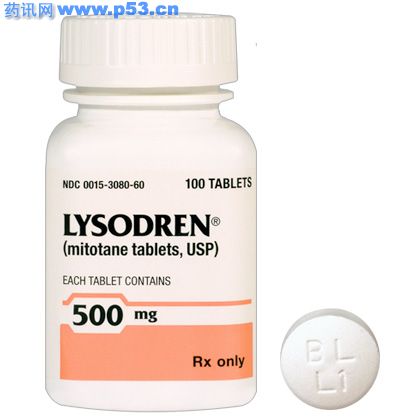|
【别名】氯苯二氯乙烷、曼托坦、密妥坦 (米托坦) 解腺瘤片,解腺瘤、Chloditan、Chlonlithane。 包装规格: 500毫克/片 30片/瓶 中文参考商品译名:
Lysodren® (mitotane tablets, USP) is an oral chemotherapeutic agent. It is best known by its trivial name, o,p′-DDD, and is chemically, 1,1-dichloro-2-(o-chlorophenyl)-2-(p-chlorophenyl) ethane. Lysodren is a white granular solid composed of clear colorless crystals. It is tasteless and has a slight pleasant aromatic odor. It is soluble in ethanol, isooctane, and carbon tetrachloride. It has a molecular weight of 320.05. Inactive ingredients in Lysodren tablets are: avicel, Polyethylene Glycol 3350, silicon dioxide, and starch.
Data in adrenal carcinoma patients indicate that about 40% of oral Lysodren is absorbed and approximately 10% of the administered dose is recovered in the urine as a water-soluble metabolite. A variable amount of metabolite (1%-17%) is excreted in the bile and the balance is apparently stored in the tissues. Following discontinuation of Lysodren, the plasma terminal half-life has ranged from 18 to 159 days. In most patients blood levels become undetectable after 6 to 9 weeks. Autopsy data have provided evidence that Lysodren is found in most tissues of the body; however, fat tissues are the primary site of storage. Lysodren is converted to a water-soluble metabolite. No unchanged Lysodren has been found in urine or bile.
Contraindications
Lysodren should be administered with care to patients with liver disease other than metastatic lesions from the adrenal cortex, since the metabolism of Lysodren may be interfered with and the drug may accumulate. All possible tumor tissues should be surgically removed from large metastatic masses before Lysodren administration is instituted. This is necessary to minimize the possibility of infarction and hemorrhage in the tumor due to a rapid cytotoxic effect of the drug. Long-term continuous administration of high doses of Lysodren may lead to brain damage and impairment of function. Behavioral and neurological assessments should be made at regular intervals when continuous Lysodren treatment exceeds 2 years. A substantial percentage of the patients treated show signs of adrenal insufficiency. It therefore appears necessary to watch for and institute steroid replacement in those patients. However, some investigators have recommended that steroid replacement therapy be administered concomitantly with Lysodren. It has been shown that the metabolism of exogenous steroids is modified and consequently somewhat higher doses than normal replacement therapy may be required.
Drug Interactions
Carcinogenesis, Mutagenesis, Impairment of Fertility
Pregnancy
Nursing Mothers
Pediatric Use
Geriatric Use
Adverse Reactions
Overdosage
Lysodren Dosage and Administration
Treatment should be instituted in the hospital until a stable dosage regimen is achieved. Treatment should be continued as long as clinical benefits are observed. Maintenance of clinical status or slowing of growth of metastatic lesions can be considered clinical benefits if they can clearly be shown to have occurred. If no clinical benefits are observed after 3 months at the maximum tolerated dose, the case would generally be considered a clinical failure. However, 10% of the patients who showed a measurable response required more than 3 months at the MTD. Early diagnosis and prompt institution of treatment improve the probability of a positive clinical response. Clinical effectiveness can be shown by reduction in tumor mass; reduction in pain, weakness or anorexia; and reduction of symptoms and signs due to excessive steroid production. A number of patients have been treated intermittently with treatment being restarted when severe symptoms have reappeared. Patients often do not respond after the third or fourth such course. Experience accumulated to date suggests that continuous treatment with the maximum possible dosage of Lysodren is the best approach. Procedures for proper handling and disposal of anticancer drugs should be considered. Several guidelines on this subject have been published.1-4 To minimize the risk of dermal exposure, always wear impervious gloves when handling bottles containing Lysodren tablets. Lysodren tablets should not be crushed. Personnel should avoid exposure to crushed and/or broken tablets. If contact with broken tablets occurs, wash immediately and thoroughly. More information is available in the references listed below. How is Lysodren Supplied
STORAGE Store at 25°C (77°F); excursions permitted to 15°C-30°C (59°F-86°F) [see USP Controlled Room Temperature].
NIOSH Alert: Preventing occupational exposures to antineoplastic and other hazardous drugs in healthcare settings. 2004. U.S. Department of Health and Human Services, Public Health Service, Centers for Disease Control and Prevention, National Institute for Occupational Safety and Health, DHHS (NIOSH) Publication No. 2004-165. OSHA Technical Manual, TED 1-0.15A, Section VI: Chapter 2. Controlling Occupational Exposure to Hazardous Drugs. OSHA, 1999. American Society of Health-System Pharmacists. ASHP guidelines on handling hazardous drugs. Am J Health-Syst Pharm. 2006;63:1172-1193. Polovich M, White JM, Kelleher LO, eds. 2005. Chemotherapy and biotherapy guidelines and recommendations for practice (2nd ed.) Pittsburgh, PA: Oncology Nursing Society. 肾上腺皮质癌综述 一、概况 肾上腺皮质癌 (adrenocortical carcinoma,ACC) 是一罕见的恶性肿瘤,其年发病率约为1-2/100万,约占所有恶性肿瘤的0.12%。从婴幼儿到80 岁以上的老年人均可患此病,平均发病年龄为44岁。在年龄分布上肾上腺皮质癌有两个高发年龄段:一是小于5 岁的幼儿,二是40-69 岁年龄段的成年人。肾上腺皮质癌发病率无明显性别差异,男女发病比例约为1:1.3。患者多数为单侧肾上腺发病,双侧同时发病的仅占2-6%。 二、临床表现 1. 肾上腺皮质癌50%为功能性,即发生了内分泌功能改变,表现为皮质醇增多症、原发性醛固酮增多症、肾上腺嗜铬细胞瘤等,其中皮质醇增多症常见,醛固酮增多症较少出现,而其余患者均为无功能性。 2. 肾上腺皮质癌患者较少出现性激素过度分泌,若合并出现性激素水平升高,其中有1/ 3 可能是恶性肿瘤。其中约20%-34%功能性肾上腺皮质癌患者会出现男性化表现(小于5 岁的患者中有95%病例出现男性化),对任何年龄段肾上腺肿瘤患者, 出现男性化均需考虑肾上腺皮质癌可能。肾上腺皮质癌患者较少出现女性化,仅占10%,若伴有女性化表现的话,瘤体一般较大,常出现男性乳房增生,恶性程度往往较高。 3. 肾上腺肿瘤患者如果短期内突发多种肾上腺皮质激素过度分泌、库欣综合征、男性化、成年男性女性化等临床表现,均提示有发生肾上腺皮质癌的危险性。 4. 肾上腺皮质癌患者常见的临床表现有:腰胀、腰痛、腹胀、发热、消瘦、乏力、疲劳及腹部肿物,瘤体大者可出现呼吸困难、胸痛等,但均为非特异性症状。 5. 肾上腺皮质癌的常见转移部位有:肝48%、肺45%、淋巴结29%、骨13%,局部侵犯肾脏、下腔静脉较常见,分别为26%和9-19%。 三、诊断 1. 激素水平检测:功能性肾上腺皮质癌患者中,约有30%的患者会出现血浆皮质醇升高,20%出现雄激素水平升高,10%发生雌激素水平升高,1-2%有血浆醛固酮水平升高。因此可通过相关激素水平的检测来辅助诊断肾上腺皮质癌。 2. 影像学诊断: 目前普遍认为,CT检查是诊断肾上腺皮质癌的首选影像学诊断手段。其中肿瘤大小是诊断肾上腺皮质癌最重要的指标,其恶性的可能性与大小成一定的正相关,但并不是绝对可靠。大于4cm的肾上腺皮质肿瘤,CT诊断为肾上腺皮质癌的敏感性为96%,特异性为51%;大于6cm者,CT诊断肾上腺皮质癌的敏感性为90%,特异性为78%;大于8cm者,敏感性为77%,特异性为93%。CT表现的特点有:瘤体大、边缘不规则、密度不均匀、出血、坏死等,均为肾上腺皮质癌的恶性征象。中央坏死和钙化在肾上腺皮质癌中很常见,约20%的病例出现钙化。 MRI 可多平面成像,对肾上腺皮质癌的定位,观察肿瘤与邻近器官的关系以及静脉受累情况优于CT,对评价肾上腺皮质癌的静脉浸润很有价值。瘤体较大尤其是右侧的肾上腺皮质癌患者应行MRI检查有无下腔静脉瘤栓,因为9-19%的病例可能合并下腔静脉转移。 3. 病理诊断:Weiss等提出肾上腺皮质癌的9项病理特征,分别为:核异型性大;核分裂数>6/50HPF;异常核分裂;具有嗜酸性胞质的瘤细胞占全部细胞75%以上;瘤细胞呈弥漫性分布≥33%;坏死;静脉侵犯;窦隙状结构浸润;包膜浸润。以上9项中只要具备3 项即可作出肾上腺皮质癌的诊断;同时,核分裂像、不典型分裂、静脉侵犯是最重要的3 项诊断依据。细针抽吸活组织检查(FNA)已应用于诊断肾上腺肿物的性质,但也有一定风险性、有争议:其缺点是假阴性率高,肿瘤穿刺道种植出血,如果肿瘤为嗜铬细胞瘤可致严重的血液动力学改变。只有当高度怀疑肾上腺皮质癌远处转移或肾上腺转移癌、与临近器官肿瘤鉴别困难、无法手术切除,同时排除嗜铬细胞瘤时才考虑应用细针抽吸活组织检查。除此之外,均需首选手术切除活检。 四、分期与预后 3%的肾上腺皮质癌患者在诊断时分期为I期,29%为II期,20%为III期,49%为IV期。肾上腺皮质癌患者的预后非常差,总体的5年生存率报道不一,大约在16-38%,平均生存时间只有18个月。研究显示,肾上腺皮质癌有两个明确的预后因素,分别为:疾病分期以及是否接受了完整性切除。因此,I-II期患者的预后要明显好于III-IV期患者: I期患者的5年生存率为30-45%,II期为12-57%,III期为5-18%,而IV期几乎为0。肿瘤完整切除者的生存也明显好于不能切除者。完整切除者平均生存时间为13-28个月,而不能切除者仅有3-9个月。即使接受了根治性手术,仍有75-85%的患者将出现术后复发。 五、治疗 手术仍为肾上腺皮质癌的首选治疗方法,其次为化疗,有希望的化疗药物有:依托泊苷(VP-16)、阿霉素(ADM)、顺铂(DDP)、米托坦(mitotane)和链脲菌素(streptozotocin)等。其它的治疗手段包括对骨转移灶和局部淋巴结的姑息性放疗以及介入治疗等。 从具体分期来看,I期和II期患者首选手术治疗,并且不推荐进行区域淋巴结清扫。 III患者仍以选择根治性切除为主。有局部侵犯但无区域淋巴结肿大者,可仅选择根治性肿瘤切除;有局部侵犯以及区域淋巴结肿大者,属于高复发风险的患者,应同时进行区域淋巴结清扫。目前尚无证据支持根治术后使用米托坦进行辅助治疗。而对于不可切除或无法完整切除的III期患者,可选择放疗或以米托坦为基础的化疗,后者可降低约80%功能性肾上腺皮质癌患者的激素水平,并延长肿瘤进展时间以及总生存。 IV期患者则以姑息治疗为主。对产生功能影响的转移或复发灶可选择姑息切除,减轻症状;对骨转移灶的姑息放疗则有利于止痛。除此之外,IV期患者的主要治疗方法仍为米托坦联合化疗。含米托坦的化疗有19-34%部分缓解率(PR)以及激素相关症状的明显缓解。含顺铂(DDP)方案的化疗约有30%的总有效率(ORR)。而米托坦联合顺铂(DDP)方案的总有效率(ORR)则达到48.6%,总的肿瘤无进展时间为9.1个月,总生存时间为28.5个月;在该方案治疗有效的患者中,肿瘤无进展时间达到了18.2个月,总生存时间将近4年(47.7个月),其中,有19.4%的患者其无进展时间超过2年,近10%的患者无进展时间超过5年;有48.6%的患者其总生存时间超过2年,14%的患者总生存时间超过5年,较其它方案的治疗效果有显著提高。此外,该方案还有66.7%的患者出现了激素水平的下降,28.1%的患者激素水平降至正常;甚至有接近14%的患者获得化疗后进一步手术切除的机会;获得肿瘤完全缓解(CR)的患者以及化疗后接受了根治性手术的患者,其肿瘤无进展时间及总生存时间比上述时间进一步延长。此外,阿霉素(ADM)对于米托坦治疗失败的无功能性或分化差的肾上腺皮质癌也仍然有接近20%的部分缓解率(PR)。 靶向治疗药物目前在肺癌、肠癌、肾癌、肝癌等其它瘤种中已经得到了广泛应用,并取得了比传统化疗效果更加的疗效。而靶向药物如索拉非尼或舒尼替尼治疗晚期肾上腺皮质癌的相关临床试验目前也正在进行中。 |
LYSODREN(米托坦片)-专治肾上腺皮质癌简介:
【别名】氯苯二氯乙烷、曼托坦、密妥坦 (米托坦) 解腺瘤片,解腺瘤、Chloditan、Chlonlithane。 商品牌子名:LYSODREN TAB 500MG 药物製造商:Bristol-Myers Squibb 剂型:药片孕妇用药分级:C【药理】本 ... 责任编辑:admin
|
最新文章更多推荐文章更多热点文章更多 |




